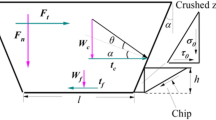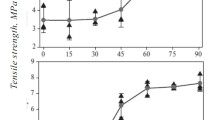Abstract
Anisotropy is an inherent property of rocks. It refers to the different response of the rock properties in each direction. Understanding the anisotropy characteristics of rock failure by drilling has practical applications in improving drilling efficiency, especially for engineering applications. In this paper, a criterion is established to clarify the ductile-to-brittle transition in the drilling process of rock. Moreover, a new anisotropy index has been proposed to evaluate the effect of anisotropy on the critical state of the ductile-to-brittle transition. The digital drilling tests are conducted on six types of rock to study the drilling mechanical performance in the X, Y, and Z directions. The anisotropy characteristics of drilling parameters and mechanical specific energy (MSE) are analysed at the critical state of ductile–brittle failure. The results show that the critical state of ductile–brittle failure is manifested as an inflection point of the depth of cut. The evolution of MSE is fitted as two linear functions, which corresponds to the two stages. The order of anisotropy in MSE is obtained as: gneiss > slate > red sandstone > granite > argillaceous sandstone > sandstone. The anisotropy in the uniaxial compressive strength and MSE for different rock types has the same sequences. The advantages of the proposed method in determining rock anisotropy are illustrated.


















Similar content being viewed by others
References
Atkins AG (2003) Modelling metal cutting using modern ductile fracture mechanics: quantitative explanations for some longstanding problems. Int J Mech Sci 45(2):373–396
Bifano TG, Fawcett SC (1991) Specific grinding energy as an in-process control variable for ductile-regime grinding. Precis Eng 13:256–262
Bifano TG, Dow TA, Scattergood RO (1991) Ductile-regime grinding: a new technology for machining brittle materials. Manuf Sci E-T ASME 113(2):184–189
Brown ET, Green SJ, Sinha KP (1981) The influence of rock anisotropy on hole deviation in rotary drilling—a review. Int J Rock Mech Min Sci Geomech Abstr 18:387–401
Dai XW, Huang ZW, Shi HZ, Wu XG, Xiong C (2012) Cutting force as an index to identify the ductile-brittle failure modes in rock cutting. Int J Rock Mech Min 146:104834
Detournay E, Defourny P (1992) A phenomenological model for the drilling action of drag bits. Int J Rock Mech Min Sci 29:13–23
Detournay E, Richard T, Shepherd M (2008) Drilling response of drag bits: theory and experiment. Int J Rock Mech Min Sci 45:1347–1360
Franca LFP (2010) Drilling action of roller-cone bits: modeling and experimental validation. J Energy Resour Technol 132:1–9
Gerbaud L, Menand S, Sellami H (2006) PDC Bits: all comes from the cutter rock interaction. Proc IADC/SPE Drill Conf Held Miami, Florida, USA 2:21–23
Han TC, Gurevich B, Fu LY, Qi QM, Wei JX, Chen XY (2020) Combined effects of pressure and water saturation on the seismic anisotropy in artificial porous sandstone with aligned fractures. J Geophys Res-Sol EA 125(1):e2019JB019091
Hareland GA (2010) Drilling rate model for roller cone bits and its application. In: Proceedings of the CPS/SPE International Oil & Gas Conference and Exhibition in China Held in Beijing, China, pp. 8–10.
He XQ, Xu CS (2015) Discrete element modelling of rock cutting: from ductile to brittle transition. Int J Numer Anal Met 39(12):1331–1351
He XQ, Xu CS (2016) Specific energy as an index to identify the critical failure mode transition depth in rock cutting. Rock Mech Rock Eng 49(4):1461–1478
He XQ, Xu CS, Peng K, Huang G (2017) On the critical failure mode transition depth for rock cutting with different back rake angles. Tunn Undergr Sp Tech 63:95–105
He MM, Huang B, Li N, Zhu CH, Chen YS (2018) Energy dissipation-based method for fatigue life prediction of rock salt. Rock Mech Rock Eng 51:1447–1455
He MM, Li N, Zhang ZQ, Yao X, Chen YS, Zhu CH (2019) An empirical method for determining the mechanical properties of jointed rock mass using drilling energy. Int J Rock Mech Min 116:64–74
He MM, Li N, Zhu J, Chen YS (2020) Advanced prediction for field strength parameters of rock using drilling operational data from impregnated diamond bit. J Petrol Sci Eng 187:106847
He MM, Zhou JP, Li PF, Yang BB, Wang HY, Wang J (2022) Novel approach to predict the spatial distributions of hydraulic conductivity of rock mass using convolutional neural networks. Q J Eng Geol Hydrogeol. https://doi.org/10.1144/qjegh2021-169
Hornby BE, Schwartz LM, Hudson JA (1994) Anisotropic effective-medium modeling of the elastic properties of shales. Geophysics 59:1570–1583
Huang SL, Wang ZW (1997) The mechanics of diamond core drilling of rocks. Int J Rock Mech Min Sci 34:612
Huang H, Lecampion B, Detournay E (2013) Discrete element modeling of tool-rock interaction I: rock cutting. Int J Numer Anal Met 37(13):1913–1929
Ismael MA, Imam HF, El-Shayeb Y (2014) A simplified approach to directly consider intact rock anisotropy in Hoek-Brown failure criterion. J Rock Mech Geotech 6(5):486–492
Kalantari S, Hashemolhosseini H, Baghbanan A (2018) Estimating rock strength parameters using drilling data. Int J Rock Mech Min Sci 104:45–52
Kuila U, Dewhurst DN, Siggins AF, Raven MD (2011) Stress anisotropy and velocity anisotropy in low porosity shale. Tectonophysics 503:34–44
Liu WJ, Zhu XH, Jing J (2018) The analysis of ductile-brittle failure mode transition in rock cutting. J Petrol Sci Eng 163:311–319
Merchant ME (1945) Basic mechanics of the metal cutting process. J Appl Phys 66:168–175
Nakajima I, Kinoshita S (1979) Theoretical studies on cutting force of rock fracture mechanism in rock cutting. J Min Metall Inst Jpn 95:49–55
Nasseri MH, Mohanty B (2008) Fracture toughness anisotropy in granitic rocks. Int J Rock Mech Min 45:167–193
Nicodeme P (1997) Transition between ductile and brittle mode in rock cutting. Rapport de stage d'option scientififique. Ecole Polytechnique, Paris.
Nishimatsu Y (1972) The mechanics of rock cutting. Int J Rock Mech Min Sci 9:261–270
Pessier RC, Fear MJ (1992) Quantifying common drilling problems with mechanical specific energy and a bit-specific coefficient of sliding friction. In: Proceedings of the 67th Annual Technical Conference and Exposition of the SPE. Washington, DC, vols. 4–7, pp. 373–387.
Ramamurthy T (1993) Strength and modulus responses of anisotropic rocks. Comprehensive rock engineering. Oxford: Pergamon Press 313–29.
Richard T, Dagrain F, Poyol E, Detournay E (2012) Rock strength determination from scratch tests. Eng Geol 147:91–100
Richard T, Detournay E, Drescher A, Nicodeme P, Fourmaintraux D (1998) The scratch test as a means to measure strength of sedimentary rocks. Paper presented at the SPE/ISRM Rock Mechanics in Petroleum Engineering, Trondheim. pp. 15–22.
Richard T (1999) Determination of rock strength from cutting tests. Master Thesis, University of Minnesota.
Roxborough FF, Philips HR (1975) Rock excavation by disc cutter. Int J Rock Mech Min Sci 12(12):361–376
Saroglou H, Tsiambaos G (2008) A modified Hoek-Brown failure criterion for anisotropic intact rock. Int J Rock Mech Min 45(2):223–234
Saroglou C, Qi SW, Guo S, Wu F (2019) ARMR, a new classification system for the rating of anisotropic rock masses. B Eng Geol Environ 78(5):3611–3626
Schunnesson H (1996) RQD predictions based on drill performance parameters. Tunn Undergr Sp Tech 11:345–351
Sun HF, Vega S, Tao G (2017) Analysis of heterogeneity and permeability anisotropy in carbonate rock samples using digital rock physics. J Petrol Sci Eng 156:419–429
Swenson DV, Wesenberg DL, Jones AK (1981) Analytical and experimental investigations of rock cutting using polycrystalline diamond compact drag cutters. SPE Annual Technical Conference and Exhibition. Society of Petroleum Engineers.
Thomsen L (1986) Weak elastic anisotropy. Geophysics 51:1954–1966
Wang ZJ (2002) Seismic anisotropy in sedimentary rocks, part 2: laboratory data. Geophysics 67(5):1423–1440
Wang Q, Gao HK, Jiang B (2018a) Relationship model for the drilling parameters from a digital drilling rig versus the rock mechanical parameters and its application. Arab J Geosci 11:357
Wang Q, Gao S, Jiang B, Li S, He M, Gao H, Qin Q (2018b) Rock-cutting mechanics model and its application based on slip-line theory. Int J GeoMech 18(5):04018025
Wang Q, Qin Q, Jiang B, Li SC (2018c) Upper bound analytic mechanics model for rock cutting and its application in field testing. Tunn Undergr Space Technol 73:287–294
Wang Q, Gao HK, Yu HC, Jiang B, Liu BH (2019) Method for measuring rock mass characteristics and evaluating the grouting-reinforced effect based on digital drilling. Rock Mech Rock Eng 52:841–851
Wang Q, Gao HK, Jiang ZH, Li SC, Jiang B (2020) Development and application of a surrounding rock digital drilling test system of underground engineering. Chin J Rock Mech Eng 39:301–310
Wang HT, He MM, Zhang ZQ, Zhu J (2022) Determination of the constant mi in the Hoek-Brown criterion of rock based on drilling parameters. Int J Min Sci Technol 32(4):747–759
Wojtanowicz AK, Kuru E (1993) Mathematical modeling of PDC bit drilling process based on a single-cutter mechanics. J Energy Resour Technol 115:247–256
Yan BQ, Wang PT, Ren FH, Guo QF, Cai MF (2020) A review of mechanical properties and constitutive theory of rock mass anisotropy. Arab J Geosci 13(12):1
Zhang ZB, Wang EY, Chen D, Li XL, Li N (2016) The observation of AE events under uniaxial compression and the quantitative relationship between the anisotropy index and the main failure plane. J Appl Geophys 134:183–190
Zhou YN, Lin JS (2013) On the critical failure mode transition depth for rock cutting. Int J Rock Mech Min 62:131–137
Zhou YN, Lin JS (2014) Modeling the ductile–brittle failure mode transition in rock cutting. Eng Fract Mech 127:135–147
Acknowledgements
This study is sponsored by the National Natural Science Foundation of China (Grants No. 42177158, 11902249 and 11872301), Key Research and Development project of Shaanxi Province (No. 2022SF-412), Education Bureau of Shaanxi Province in China (Grant No. 20JS093). Opening fund of State Key Laboratory of Geohazard Prevention and Geoenvironment Protection (Chengdu University of Technology (Grants No. SKLGP2022K005). Open subject of Urban Geology and Underground Space Engineering Technology Research Center of Shaanxi Province (2022KT-01). The financial support provided by this sponsor is greatly appreciated.
Author information
Authors and Affiliations
Corresponding author
Ethics declarations
Conflict of interest
The authors declare no conflicts of interest.
Additional information
Edited by Prof. Jadwiga Anna Jarzyna (ASSOCIATE EDITOR) / Prof. Gabriela Fernández Viejo (CO-EDITOR-IN-CHIEF).
Rights and permissions
Springer Nature or its licensor (e.g. a society or other partner) holds exclusive rights to this article under a publishing agreement with the author(s) or other rightsholder(s); author self-archiving of the accepted manuscript version of this article is solely governed by the terms of such publishing agreement and applicable law.
About this article
Cite this article
He, M., Wang, J., Yuan, Z. et al. Anisotropy on the ductile-to-brittle transition for rock in process of drilling. Acta Geophys. 71, 2107–2124 (2023). https://doi.org/10.1007/s11600-023-01017-4
Received:
Accepted:
Published:
Issue Date:
DOI: https://doi.org/10.1007/s11600-023-01017-4




